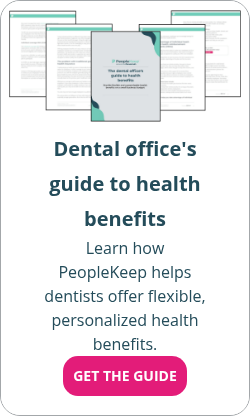Employee health insurance options for dentist offices
By Elizabeth Walker on March 13, 2024 at 11:00 AM
Like other small employers, dentists may wonder if they must offer health insurance benefits to their employees. While the Affordable Care Act (ACA) only requires organizations with 50 or more full-time equivalent employees (FTEs) to provide health insurance, smaller companies, like a dental practice, can improve their retention rate, team morale, and overall productivity by offering a comprehensive health benefit.
Worrying about the cost of adding a health benefit to your compensation package is understandable. However, many health insurance options can provide your employees with excellent coverage without breaking your budget.
In this article, we’ll go over health insurance benefits for dental practices that will help your business stay competitive and keep your assistants, hygienists, and technicians healthy.
Takeaways from this blog post:
- Traditional group health insurance is a popular plan policy option for providing health benefits to employees, but it can be cost-prohibitive for small dental practices.
- Health savings accounts and medical flexible spending accounts are customizable benefits options that can supplement a group health plan and provide employees with additional coverage and flexibility.
- Health reimbursement arrangements (HRAs) and health and wellness stipends are flexible and affordable alternatives to group plans for employers, allowing them to cover their employees’ healthcare expenses. Employees can choose the individual health insurance plan that meets their personal needs with these benefits.
Traditional group health insurance
One of the most popular health benefit options covering almost 153 million American workers is a group health plan1. Also called traditional group health insurance, this type of plan allows employers to choose group health policies for their company that their employees can enroll in at a reduced rate. Employers can buy a group plan policy through an insurance company, agent, or broker.
Applicable large employers (ALEs) subject to the ACA’s employer mandate often choose group health insurance because they can qualify for lower rates and meet an insurer’s participation requirements. Smaller businesses can also buy small group health insurance on the Small Business Health Options (SHOP) marketplace and may even save on premium costs if they qualify for the Small Business Health Care Tax Credit2.
Group health insurance entices many employers because of its familiarity and extensive network of providers. However, employers seeking a group health insurance policy can have limited plan options, be faced with restrictive plan details, and incur expensive premiums—especially for small business owners.
Premium costs can vary based on factors like your employees’ ZIP code and age. According to KFF, the average annual premium for group health insurance in 2023 is $8,435 for self-only coverage and $23,968 for family plans. Of those amounts, employers contributed $7,034 toward their employees’ self-only coverage and $17,393 toward family coverage3.
Group health insurance plans also come with steep annual rate increases, so even if you can afford a group plan now, you may not be able to in the future. A group plan also may not satisfy your employees’ individual needs.
If you want to offer a group plan and provide your staff with more flexibility, you can opt for a policy that comes with a higher deductible and supplement it with other health benefits, like the three we’ll mention in the sections below.
Group coverage health reimbursement arrangement (GCHRA)
Also called an integrated HRA, a GCHRA is for businesses that offer a group health plan. With this type of HRA, you can reimburse your employees tax-free for out-of-pocket healthcare costs that your group plan doesn’t fully cover, like coinsurance or emergency services. Only employees enrolled in your group policy can participate in the benefit, and health insurance premiums aren’t eligible for reimbursement.
Not only are GCHRAs beneficial for employers looking to make their group plans more attractive, but they’re also customizable. For example, they can be paired with any group policy you choose—including a high deductible health plan (HDHP). You can also define which out-of-pocket expenses you’d like to cover.
There are also no minimum or maximum contribution limits with a GCHRA, so you can set the allowance that works for your budget and your staff’s needs. Another way to customize your benefit is by choosing different allowance amounts by seven employee classes for extra flexibility.
Health savings accounts (HSAs)
Another way to boost your group health plan is with an HSA. HSAs allow employers and employees to contribute money on a pre-tax basis that employees can later withdraw to pay for qualified out-of-pocket costs, like emergency dental treatments or medical services. HSAs are cost-saving options for employers because they only work with HSA-qualified HDHPs, which have budget-friendlier monthly premiums.
The IRS updates HSA maximum contribution limits annually. No matter how you set up the HSA, the employee always owns the account. This means the employee keeps all their contributions in their HSA indefinitely, even if they leave your office. Even so, HSAs are a great way for employers to keep costs low while employees take advantage of healthcare savings.
Healthcare flexible spending accounts (FSAs)
The last option you can use to supplement your group plan is a healthcare FSA or medical FSA. This benefit allows employees to withdraw pre-tax dollars to pay for qualifying medical expenses, like copays, doctor visits, dental costs, and more. Like the GCHRA, FSAs don't cover health insurance premiums.
In most cases, employees submit a claim to their FSA benefit through their employer with proof of purchase of their incurred medical expenses. Once you verify that their group health plan doesn’t cover the expense, you reimburse them for the cost.
Employers and employees can contribute to an FSA up to the annual maximum limit of $3,400 in 2026. Most FSAs operate under a “use it or lose it” rule, meaning that funds not used by the plan year's end will expire. However, if you choose to permit funds to roll over to the following year, the benefit maximum amount the IRS allows you to roll over up to $680 in 20264.
Association health plans
Your next option is an association health plan (AHP). AHPs allow small businesses with fewer than 50 employees and self-employed individuals to join together to buy large group health coverage, gaining access to more insurance plan options at an affordable price. Typically, this type of plan joins businesses within the same industry, profession, or region.
AHPs work like traditional health insurance. They can cover a wide range of employees, including 1099 employees, freelancers, and contract workers, making it likely for all your staff members to receive health coverage.
However, AHPs don’t have to comply with many ACA regulations, so they’re not suitable coverage for ALEs. For example, AHP insurers can decline to pay for healthcare treatment relating to an employee’s pre-existing condition, refuse to cover some or all of the ACA's essential health benefits, and even charge higher premiums based on health status and gender.
AHPs are often a more affordable coverage option than traditional health insurance. However, if you want a plan that will provide more flexibility, help you meet ACA regulations, and cover medical services, selecting one of the following health benefits may be a better option.
Health reimbursement arrangements (HRAs)
One of the best options for employers of dental practices is a stand-alone health reimbursement arrangement (HRA). A stand-alone HRA is a flexible, tax-free health benefit that you can use to reimburse your staff for individual health insurance premiums and qualified out-of-pocket medical expenses. IRS Publication 502 and the CARES Act have a complete list of healthcare expenses for HRAs5.
HRAs are a great solution for employers of all sizes, locations, and budgets. Better yet, they’re simple to understand. With an HRA, you set a monthly allowance that your employees can spend on healthcare costs. Once employees make an approved purchase, you reimburse them tax-free up to their allowance amount.
HRAs are also employer-owned. This means that any unused funds stay with the employer if an employee leaves your company. Due to their flexibility and customizability, offering an HRA instead of group health insurance is a surefire way to better attract and retain talented workers.
Many types of HRAs may fit your needs. As mentioned earlier, the GCHRA only integrates with employer-sponsored group health insurance. However, two stand-alone HRAs are especially beneficial for dental practices: the qualified small employer HRA (QSEHRA) and the individual coverage HRA (ICHRA).
We’ll dive deeper into both of these in the sections below.
Qualified small employer HRA (QSEHRA)
If you’re running a dental office with fewer than 50 employees, then a QSEHRA is an excellent option. The QSEHRA is for small employers with fewer than 50 full-time FTEs that don't offer a group plan. Like other HRAs, QSEHRA reimbursements are income-tax-free for employees as long as their health plan provides minimum essential coverage (MEC).
The IRS sets annual maximum contribution limits for QSEHRA. But, there are no minimum contribution limits. This makes the QSEHRA a strong solution for small dental practices looking for a quality health benefit at a price they can afford.
When offering a QSHERA, you must offer it to all your W-2 full-time employees. Your part-time employees can also participate in the benefit as long as they receive the same allowance as full-time employees.
For added customization, you can design your benefit to reimburse your employees for health insurance premiums only or their premiums plus qualified out-of-pocket costs. According to our 2024 QSHERA Report, 42% of all QSEHRA reimbursements were for insurance premiums. But 58% were for non-premium expenses, like over-the-counter medicine. So, if you have the budget, a premium plus QSEHRA can help your employees get the most out of their benefit.
Individual coverage HRA (ICHRA)
While the QSHERA is only for small employers, an ICHRA is available for organizations of all sizes. This makes it particularly attractive for ALEs looking to satisfy the employer mandate without enrolling in costly group health insurance.
The ICHRA works much like the QSEHRA but has no contribution limits. You can also set different allowance amounts based on 11 job-based employee classes, making it easier to customize the benefit to meet your and your staff’s needs.
The ICHRA can only cover employees with an individual health insurance plan that meets MEC. Employees covered by a family member's group policy or with alternative coverage, like a healthcare sharing ministry, can't participate in the benefit.
However, your staff that can participate can select the individual health plan—whether on- or off-exchange—that works best for them and their families and use their ICHRA benefit to cover their premiums and other medical expenses.
Health and wellness stipends
The last option for current dentists running their own practice is a stipend. While employers can offer several types of stipends, a health or wellness stipend is the type you’d want to set up for comprehensive coverage.
Using a health stipend, you can offer your employees a set amount of money to pay for individual and supplemental health insurance premiums and other additional costs, like prescription drugs, dental coverage, and emergency services.
Health stipends are flexible, meaning they can work alongside other comprehensive plans like group health insurance, AHPs, or HRAs without compliance issues. But, health stipends don’t satisfy the ACA’s employer mandate on their own if your company is an ALE.
With wellness stipends, you can help your employees offset additional costs of their wellness-related expenses, like gym memberships, mental health counseling, and home exercise equipment. Coupling a wellness and health stipend and a formal health benefit, like an HRA, is a great way to support your employees’ health and well-being, reduce sick days for major services, and provide your staff with the most comprehensive coverage possible.
Stipends have no contribution limits, so you can offer your employees as little or as much money as you choose. You can also set your preferred payment schedule. For example, you can process your stipend as a one-time lump payment, a recurring payment, or as reimbursement using a stipend plan administrator software.
Lastly, the IRS considers stipends taxable income. This means you must pay payroll taxes on the amount, and your employees are subject to income taxes when they file their tax returns.
Conclusion
In addition to dental health, keeping your employees healthy and happy by offering a robust benefits package should be a top priority if you’re running a dentist's office. While finding a budget-friendly and comprehensive plan to meet your dental practice’s needs can seem daunting, understanding your available options is an excellent first step toward making the right coverage choice for you and your employees.
If you need help choosing the right health benefits for your company, PeopleKeep has just what you need. We’ve helped small dental offices across the country offer personalized benefits. With our HRA software solution, you can provide your dental staff with customized and flexible benefits that everyone will love.
Contact a PeopleKeep personalized benefits advisor to learn how we can help your small business.
1. https://www.kff.org/report-section/ehbs-2023-summary-of-findings/
2. https://www.healthcare.gov/small-businesses/choose-and-enroll/shop-marketplace-overview/
Check out more resources
See these related articles

Health insurance options for franchises
Are you a franchise owner? Explore your health insurance options with this comprehensive guide, tailored specifically for franchises.

Can I have an HRA and an FSA at the same time?
Learn if you can have an HRA and an FSA at the same time. Understand the rules, benefits, and how these accounts can work together for healthcare costs.

What is healthcare reimbursement?
Looking to reimburse your employees for their healthcare expenses? Learn everything you need to know about healthcare reimbursement.



